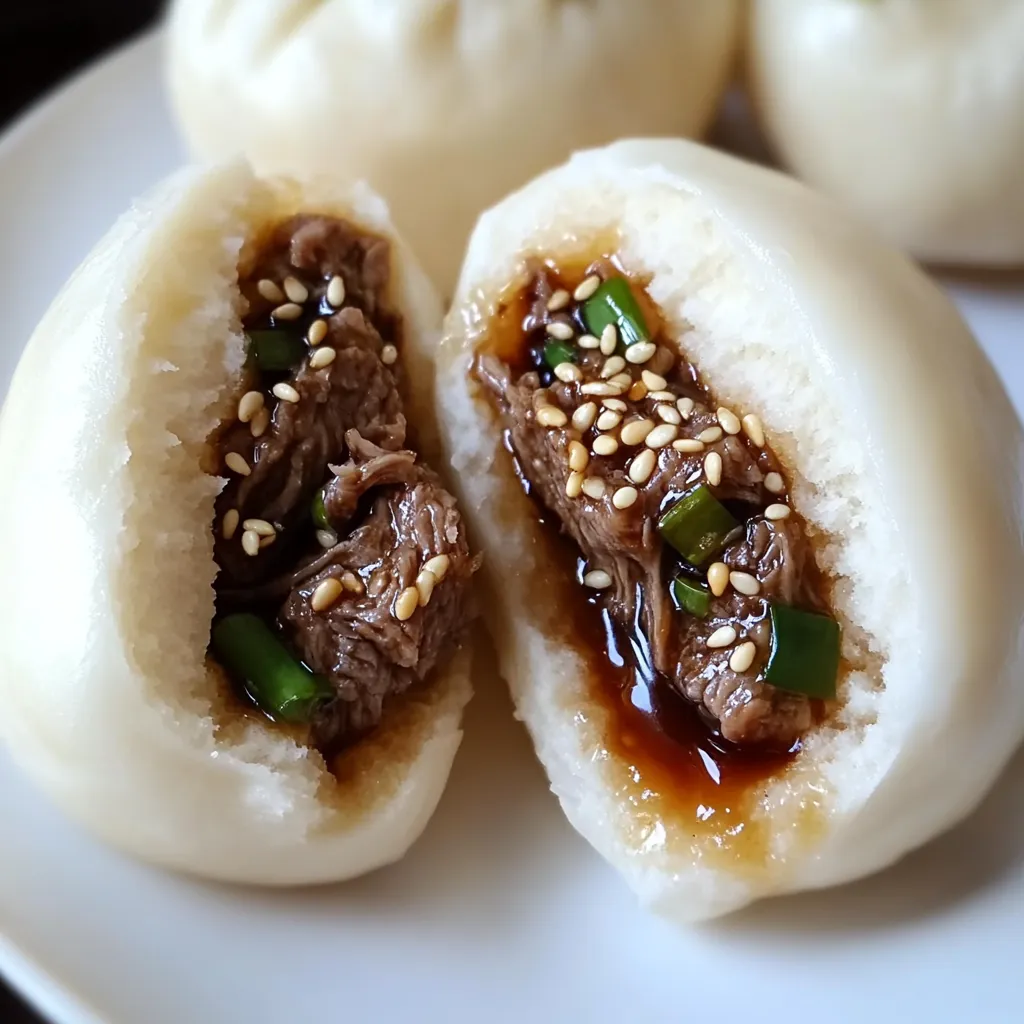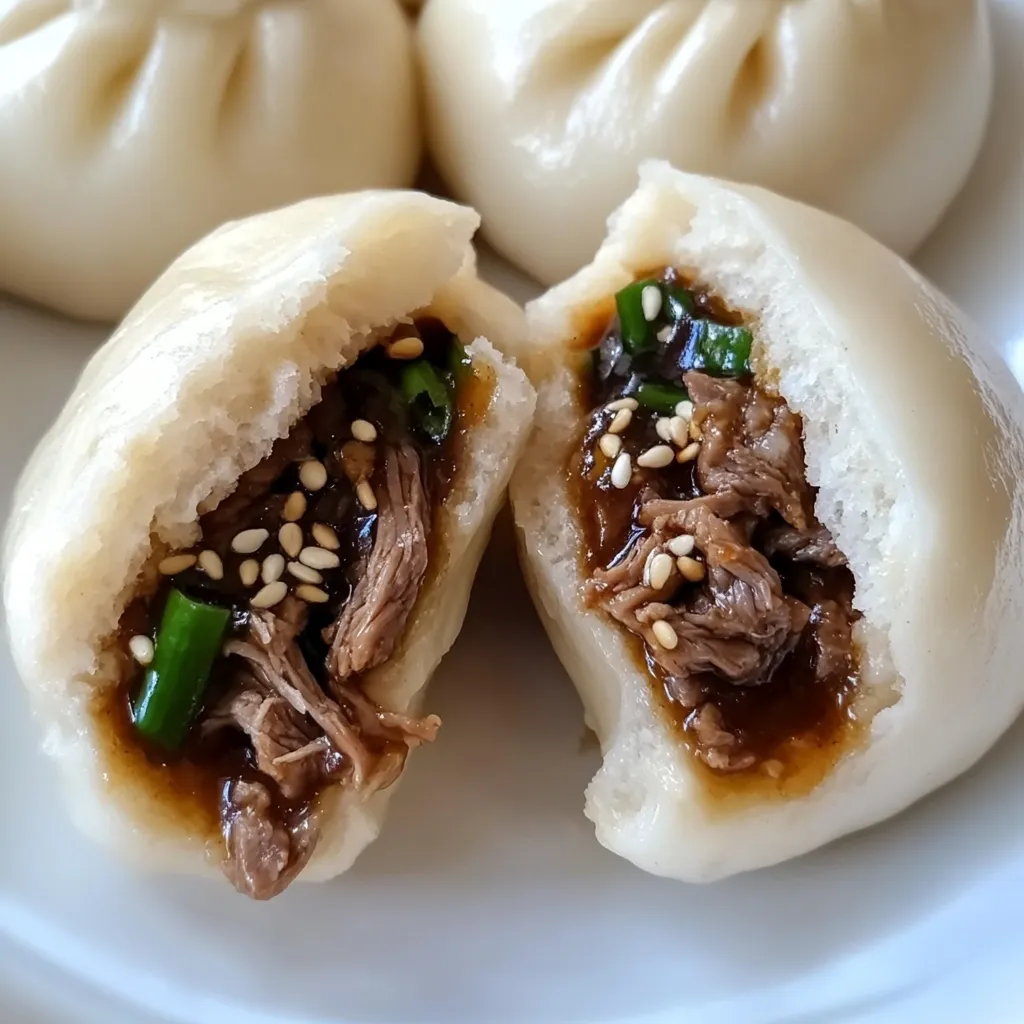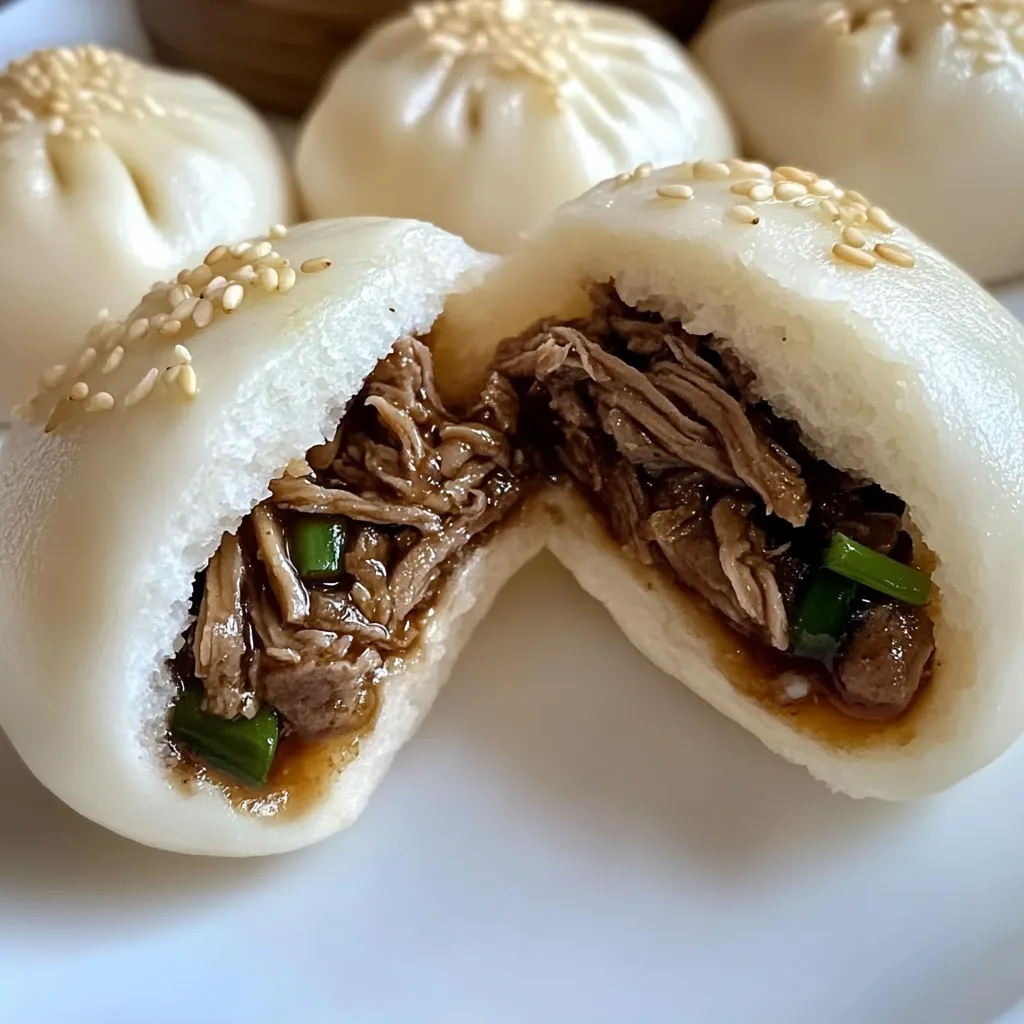 Save
Save
Pillowy soft dough cradles savory, melt-in-your-mouth beef filling in these irresistible homemade steamed buns that bring authentic dim sum flavor right to your kitchen. The contrast between the tender, slightly sweet dough and the rich, umami-packed filling creates a perfect harmony of textures and flavors in each bite. These baos strike an impressive balance—substantial enough for a meal yet delicate enough to serve as an appetizer or snack for any occasion.
The first time I attempted making bao buns myself, I was intimidated by the steaming process and worried the dough wouldn't rise properly. Now after years of perfecting my technique, I find making these beef-filled pockets therapeutic—the rhythmic kneading of the dough, the careful pleating of each bun, and the excitement of lifting the steamer lid to reveal perfectly puffed clouds of deliciousness never fails to bring satisfaction.
Essential Components
- All-Purpose Flour: Creates the foundation for the soft, chewy bun exterior. Select unbleached flour for better flavor and texture, with enough protein content to develop proper structure while remaining tender.
- Active Dry Yeast: Provides essential rise and fluffiness to the dough. Fresh yeast ensures even, reliable rising—check expiration dates before beginning your bao adventure.
- Sugar: Adds slight sweetness to the dough while providing food for the yeast. Use plain white sugar for clean flavor that doesn't compete with the filling.
- Warm Milk: Creates a tender crumb and adds richness to the dough. The protein in milk helps develop structure while the fat contributes softness to the finished buns.
- Beef Chuck: Ideal cut for slow-cooking that breaks down beautifully during simmering. Choose well-marbled pieces that will remain tender and juicy after cooking.
- Soy Sauce: Provides essential umami foundation and salt for the filling. Select naturally brewed varieties for cleaner flavor and better depth.
- Hoisin Sauce: Creates sweet-savory balance with complex flavor notes. This thick, fragrant sauce adds characteristic Chinese barbecue notes that define good bao.
- Fresh Ginger: Adds aromatic warmth and slight spiciness to cut through rich flavors. Always use fresh for better flavor penetration throughout the filling.
- Garlic: Provides essential aromatic base notes that permeate the entire filling. Mince finely to distribute evenly throughout the beef mixture.
- Sesame Oil: Just a small amount adds distinctive nutty fragrance that elevates the entire dish. Use toasted varieties for more pronounced flavor.
Bao Creation
- Dough Development:
- Combine warm milk, sugar, and yeast in a large bowl, allowing mixture to sit until foamy and activated, about 5-10 minutes. The liquid should look bubbly and smell pleasantly yeasty, indicating active fermentation has begun.
- Dough Formation:
- Add flour gradually to the liquid ingredients, stirring initially with a wooden spoon until a shaggy dough forms. Transfer to a floured surface and knead for 8-10 minutes until smooth and elastic, developing the gluten structure that creates perfectly fluffy buns.
- Primary Rise:
- Place dough in an oiled bowl, cover with plastic wrap or a damp cloth, and allow to rise in a warm location until doubled in size, approximately 60-90 minutes. The dough should feel puffy and spring back slowly when gently pressed with a fingertip.
- Filling Preparation:
- While dough rises, heat sesame oil in a skillet over medium heat. Add minced garlic and ginger, cooking until fragrant but not browned, about 30 seconds. This aromatic base creates the foundation for your filling's complex flavor profile.
- Meat Cooking:
- Add finely chopped beef to the aromatics, cooking until browned on all sides. Pour in soy sauce, hoisin sauce, and a small amount of water or broth. Reduce heat to low and simmer until beef becomes fork-tender and sauce thickens to a glossy consistency.
- Dough Dividing:
- After rising, gently punch down dough to release air bubbles, then transfer to a clean surface. Divide into equal portions (approximately 12-16 depending on desired size) using a bench scraper for clean cuts. Roll each portion into smooth balls, covering with a kitchen towel to prevent drying.
- Bun Formation:
- Working with one dough ball at a time, flatten into a disc about 4-5 inches in diameter, making the edges slightly thinner than the center. Place a generous tablespoon of filling in the middle, then gather the edges upward, pleating and pinching to create a sealed bun.
- Steam Process:
- Line a bamboo steamer with parchment paper or cabbage leaves to prevent sticking. Arrange filled buns with at least 2 inches between them to allow for expansion. Steam over simmering water for 12-15 minutes until buns are puffed, shiny, and springy to the touch.
 Save
Save
My grandmother always insisted on pleating each bao precisely thirteen times, claiming this brought good luck and perfect texture. While I've never confirmed any mystical properties in the thirteen-pleat method, I still find myself counting each fold when making these buns, honoring her teaching and the meditative rhythm she instilled in me during our kitchen sessions. The repetitive motion of pleating has become my favorite part of the process, transforming simple ingredients into something both beautiful and delicious.
Serving Inspirations
These versatile buns create beautiful harmony with complementary sides and sauces that enhance their flavor. Serve alongside quick-pickled vegetables like thinly sliced cucumber or daikon radish dressed with rice vinegar for refreshing contrast to the rich filling. For dipping, offer Chinese black vinegar mixed with thin slivers of ginger, which cuts through the richness while adding bright acidity to each bite.
Creative Variations
This adaptable recipe welcomes numerous interpretations while maintaining its essential character. For spice enthusiasts, incorporate finely chopped chilies or a dollop of chili oil into the beef filling. Vegetarians might substitute finely chopped shiitake mushrooms and crumbled tofu seasoned with the same sauce mixture for a remarkably similar texture and flavor profile. For added freshness, tuck a small piece of steamed bok choy into each bun alongside the beef filling.
Keeping It Fresh
Store leftover bao buns in airtight containers, separated by parchment paper to prevent sticking. Refrigerate for up to three days, maintaining both flavor and texture. Revive chilled buns by steaming for 5-6 minutes until heated through. For longer storage, freeze completely cooled buns in a single layer before transferring to freezer bags, where they'll maintain quality for up to two months.
 Save
Save
After preparing countless batches of these tender beef bao buns, I've found they represent the perfect balance between culinary challenge and achievable home cooking. The process requires attention and care, but rewards you with results that genuinely impress. Whether shared with family on a quiet evening or served to guests as part of a larger Asian-inspired spread, these pillowy pockets of flavor create moments of joy around the table—exactly what cooking should accomplish.
Common Questions About Cooking
- → Can I make the dough ahead of time?
- Yes! You can make the dough up to 24 hours ahead and keep it in the refrigerator. Just let it come to room temperature for about 30 minutes before shaping the buns.
- → What if I don't have a steamer?
- You can create a makeshift steamer by placing a heat-proof plate on top of aluminum foil balls or a small bowl in a large pot with water. Cover the pot with a tight-fitting lid and steam as directed.
- → Can I freeze these bao buns?
- Absolutely! Place cooled buns on a baking sheet until frozen solid, then transfer to a freezer bag. They'll keep for up to 3 months. Steam frozen buns for 8-10 minutes to reheat.
- → What other fillings work well in bao buns?
- You can fill bao with almost anything! Try pulled pork with hoisin sauce, teriyaki chicken, tempeh or tofu for vegetarian options, or even sweet fillings like red bean paste or custard.
- → Why didn't my buns turn out fluffy?
- This could be due to old yeast, not enough rising time, or overworking the dough. Make sure your yeast is fresh, allow proper rising time in a warm place, and handle the dough gently when shaping.
